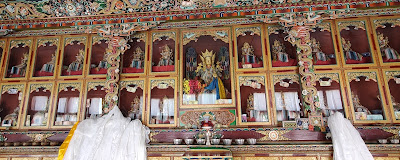In the past few weeks, I’ve shared my experiences visiting several shrines in Ladakh during my trip with Mantra Yatra in August. This is the final installment of the series. You can catch up on the previous entries here: Part I, Part II, Part III.
This post focuses on the breathtaking Thiksey Monastery, located in the Indus Valley at an elevation of approximately 11,800 feet. This impressive twelve-story structure houses an array of shrines, statues, thangkas, a library, and a nunnery, all arranged around a grand courtyard.
| The pathway leading to Thiksey Monastery |
Thiksey Monastery is the largest in Central Ladakh, located about 19 kilometers from the city of Leh. Its architectural style is said to resemble the Potala Palace in Lhasa, Tibet. The monastery’s history is enriched by an intriguing legend. In the early 15th century, Je Tsongkhapa, the founder of the Gelug school of Tibetan Buddhism and revered as the second Buddha after his passing, dispatched six of his disciples across Tibet and Ladakh to share the teachings of his school. One of these disciples, Jangsem Sherap Zangpo, was gifted a statue of Amitayus made from bone powder and his own blood to present to the King of Ladakh, with the goal of seeking the King’s support in promoting his teachings in the region.
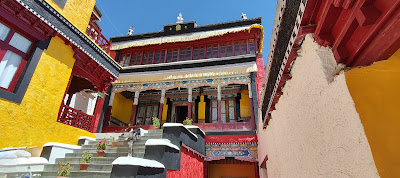 |
| The magnificent monastery complex |
Thrilled with the gift, the king quickly instructed his ministers to assist Zangpo in establishing a monastery in Ladakh. Consequently, in 1433, a small monastery named Lhakang Serpo or Yellow Temple was founded. The Gelug practitioners, known as “Yellow Hats” due to their distinctive golden robes, can be seen throughout the monastery.
One day, while conducting sacred rituals near the temple, Sherap Zangpo and his disciple Palden Zangpo were startled when a crow swooped down and snagged their offerings. Following the unexpected thief, they discovered the offerings intact on a stone in Thiksey. Interpreting this as a divine sign, Palden Zangpo decided to construct a larger monastery at this site, which he considered a sacred indication from his master. The monastery is home to four main shrines: the Maitreya Buddha (the Future Buddha), Tara Devi, the main prayer hall, and the Guardian Deity shrine dedicated to Yamantaka.
Maitreya Buddha: This massive 40-foot Maitreya Buddha statue extends over two floors. The Thiksey Rimpoche, Kushok Nawang Chamba Stanzin, played a vital role in its creation. Crafted from clay and terracotta and adorned in gold and copper, the statue took a team of thirty artisans three years to complete. The Dalai Lama’s commentary during its consecration on July 26, 1980, encapsulates the wonder felt by all who stand before this stunning figure.
“Even if you see this Maitreya again and again, you will never see it enough; you will always want to see more – you would never be satisfied.”
Indeed, the image of the Maitreya Buddha and the ethereal beauty of the shrine linger in one’s memory long after leaving the monastery.
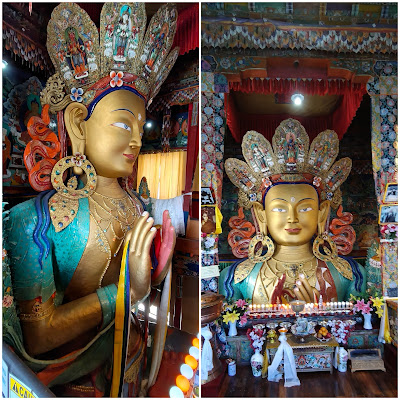 |
| The 40-foot Maitreya Buddha |
Main Prayer Hall:
The main prayer hall contains large drums, rows of seating for monks and visitors, and exquisite murals adorning the walls. At its center, there is a shrine dedicated to the Buddha, surrounded by Bodhisattvas, and features various scriptures and sacred texts elegantly wrapped in silk.
 |
| Main Prayer Hall |
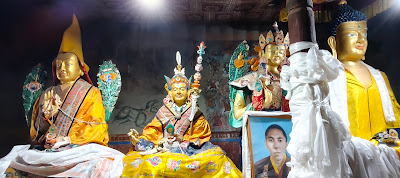 |
| Buddha flanked by Bodhisattvas in the sanctum |
Tara Devi Shrine:
Tara Devi is regarded as the mother of Sakyamuni Buddha and is said to have emerged from Avalokiteswara’s tears, shed in sorrow for human suffering. She appears in 21 distinct forms. One legend portrays Tara as a powerful symbol of feminism. Known as Princess Yashe Dawa, she made countless offerings to the Buddha across eons, ultimately achieving the status of Bodhisattva. Upon reaching this level, some monks advised her to pray to be reborn as a man to further her spiritual progress.
Tara responded with determination, asserting that only the weak-minded would consider gender a barrier to enlightenment. She vowed to always be reborn as a female Bodhisattva, declaring, “I have developed bodhicitta as a woman. Throughout all my lifetimes on the path, I vow to be reborn as a woman, and when I ultimately achieve Buddhahood in my final life, I will still be a woman.”
Tara Devi in all 21 forms
In the Tara Devi shrine, you will find images of all her twenty-one forms displayed in a wooden cabinet. The top floor of the temple, known as the Lamokhang Temple, houses sacred sculptures that are accessible only to men.
The Guardian Shrine:
This is considered the most powerful shrine in the entire monastery complex. It features the Vajra Bhairava Ekavira, a wrathful depiction of the Bodhisattva Manjushri. Manjushri is traditionally portrayed in a formidable form, inspiring fear in onlookers. Consequently, visitors are discouraged from facing the deity, whose face is kept covered year-round except for the three days of the Gustor Festival in October-November. Accompanying this deity are the Shaturbuja Mahakala and Yamaraj on either side.
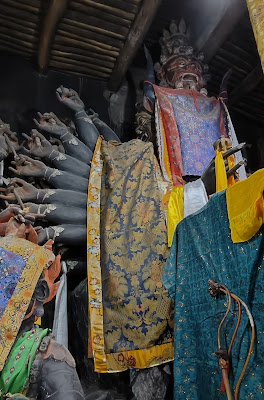 |
| Guardian Deity with Mahakala |
The Vajra Bhairava has nine faces, thirty-four hands, and sixteen legs. Its primary face resembles that of a buffalo, topped with a red face and the likeness of Manjushri. Flames swirl around the horns, and three faces are stacked on either side, each adorned with three eyes, bared fangs, and a fierce expression. The deity is crowned with skulls, a necklace of snakes, and a garland of fifty heads. One leg crushes eight creatures while the other presses down eight birds.
The monastery also includes a nunnery for female monks. Beyond the main shrines, there is a room dedicated to teaching local children interested in becoming monks, as well as a library filled with a vast collection of sacred texts. The rooftop offers stunning views of the Himalayas and the Indus Valley, accompanied by a lovely store and café.
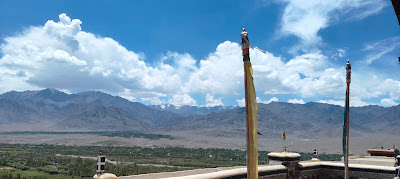 |
| View from the rooftop |
How to Get There: Thiksey Monastery is located 19 kilometers from the city of Leh. Be sure to include it in your itinerary. Be prepared for significant climbing both to reach the monastery and to explore each of the shrines.


